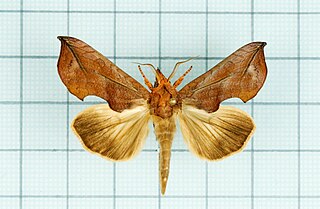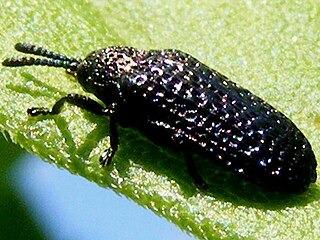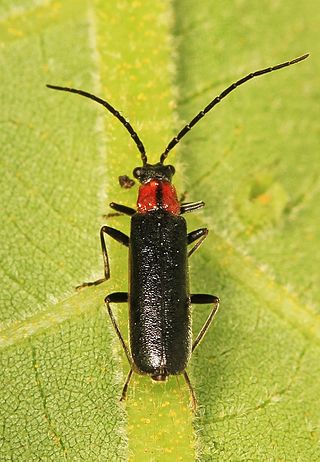
Excavata is an extensive and diverse but paraphyletic group of unicellular Eukaryota. The group was first suggested by Simpson and Patterson in 1999 and the name latinized and assigned a rank by Thomas Cavalier-Smith in 2002. It contains a variety of free-living and symbiotic protists, and includes some important parasites of humans such as Giardia and Trichomonas. Excavates were formerly considered to be included in the now obsolete Protista kingdom. They were distinguished from other lineages based on electron-microscopic information about how the cells are arranged. They are considered to be a basal flagellate lineage.
Alsophila excavata, synonym Cyathea excavata, is a species of tree fern endemic to the Cameron Highlands in Peninsular Malaysia, where it grows in habitats ranging from forest, streamsides, clearings and open grassy areas at an altitude of approximately 1800 m. The trunk is erect and up to 2 m tall or more. It forms lateral shoots. Fronds are bi- or tripinnate and about 2 m long. They are persistent and may be retained forming a characteristic skirt around the trunk. The stipe is smooth, green and covered with dull, thin basal scales. Sori occur near the fertile pinnule midvein and are covered by pale, thin indusia that are saucer-like in appearance.

Retaria is a clade within the supergroup Rhizaria containing the Foraminifera and the Radiolaria. In 2019, the Retaria were recognized as a basal Rhizaria group, as sister of the Cercozoa.

Protozoan infections are parasitic diseases caused by organisms formerly classified in the kingdom Protozoa. These organisms are now classified in the supergroups Excavata, Amoebozoa, Harosa, and Archaeplastida. They are usually contracted by either an insect vector or by contact with an infected substance or surface.

Vitekorchis excavata, also known as the hollow oncidium, is a species of orchid native to the Neotropics.
Andalucia is a genus of jakobids, currently containing the sole species A. godoyi.

Calyptraea, commonly known as the Chinese hat snails is a genus of sea snails, marine gastropod mollusks in the family Calyptraeidae, a family which contains the slipper snails or slipper limpets, cup-and-saucer snails, and Chinese hat snails.

Clausena is a genus of flowering plants in the citrus family, Rutaceae. It was first defined by the Dutch botanist Nicolaas Laurens Burman in 1768. It is distributed in Africa, southern Asia, Australia, and the Pacific Islands.

Oraesia excavata is a species of moth of the family Erebidae first described by Arthur Gardiner Butler in 1878. It is found in Japan, Korea, China, Thailand and Taiwan and has recently been recorded from Hawaii.

Clausena excavata is a species of evergreen shrub that grows 1–2 metres tall, in the family Rutaceae, native to Bangladesh, Bhutan, Cambodia, China, India, Indonesia, Laos, Malaysia, Myanmar, Nepal, the Philippines, Taiwan, Thailand, and Vietnam. The plant is commonly by various names, including pink lime-berry, cama, cemama, cemamar, cerek, cerek hitam, kemantu hitam, secerek, semeru, and suntang hitam.

Asclera is a genus of false blister beetles in the family Oedemeridae. There are about six described species in Asclera.

Lichenomima is a genus of mouse-like barklice in the family Myopsocidae. There are more than 40 described species in Lichenomima.

Chionea alexandriana is a species of snow fly (chionea) in the family Limoniidae. The species is common in the western mountains of North America, including Alberta, British Columbia, Washington State, Oregon, Idaho, Montana, Utah, and California. J.A. Chapman (1954), working in Montana, found them to be most abundant in snow fields at 3600-7000 feet elevation from November to April at temperatures ranging from 21-32 degrees F.

Asclera puncticollis is a species of false blister beetle in the family Oedemeridae. It is found in North America.
Asclera nigra is a species of false blister beetle in the family Oedemeridae. It is found in North America.

Proisotoma is a genus of elongate-bodied springtails in the family Isotomidae. There are at least 50 described species in Proisotoma.

Microrhopala is a genus of tortoise beetles and hispines in the family Chrysomelidae. There are about 18 described species in Microrhopala.
Asclera discolor is a species of false blister beetle in the family Oedemeridae. It is found in North America.

Rhagonycha excavata is a species of soldier beetle in the family Cantharidae. It is found in North America.

Microrhopala excavata is a species of leaf beetle in the family Chrysomelidae. It is found in North America.













